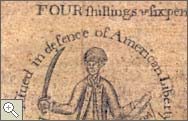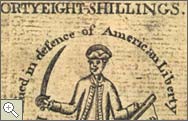|
|
 |
 |
 |
|
Introduction |
|
Improvised Money
-
Money as Message
-
Buying Time
-
MiffPellings
|
 |
 |
 |

In 1775, the Continental Congress issued the colonies' first uniform currency, the bills that came to be called "Continentals." On a Continental designed by Benjamin Franklin, there is a depiction of the thirteen colonies as linked rings, which form a circle around the inscription WE ARE ONE. On the other side, Franklin offered a bit of Poor Richard—like advice: MIND YOUR BUSINESS.
The colonies, soon to call themselves states, issued their own bills. Like the Continentals, this money served both to finance and to promote the war effort. Some of the bills could be read like political broadsides.
On the front of the 1775 bill on the facing page, King George III (the figure closest to the center) is trampling the Magna Charta, a symbol of ancient English freedoms, as he personally sets fire to an American city. To George’s left, the allegorical figure Britannia receives a petition from an allegorical, who leads an advancing army of patriots. tramples a scroll labeled SLAVERY.
For all of the stridency of this message, the reverse side shows Britannia and America holding an olive branch between them. The inscription, PAX TRIUMPHIS POTIOR, means “Peace is preferable to victory."
The bill was issued a few weeks after the Continental Congress signed two rather divergent documents: the so-called Olive Branch Petition, an elaborately polite appeal to the king for peace, and the Declaration of the Causes and Necessity of Taking Up Arms, which stated that the colonists did not have "designs of separating from Great-Britain, and establishing independent states," but would nevertheless "die free men rather than live as slaves."
The Magna Charta also appears on one of the two Paul Revere—designed Massachusetts bills on page 7. On the 1775 bill, the patriot is armed with the sacred symbol as well as the sword. The American cause, then, is in keeping with English tradition.
On the 1776 bill, there is one big difference:MAGNA CHARTA is replaced by an intractable pledge, INDEPENDENCE.
|
 |
 |
 |
 |

Massachusetts, December 7, 1775
|
 |
 |
 |
 |
 |
 |

Massachusetts, November 17, 1776
|
 |
 |
 |
|




|
|
|

